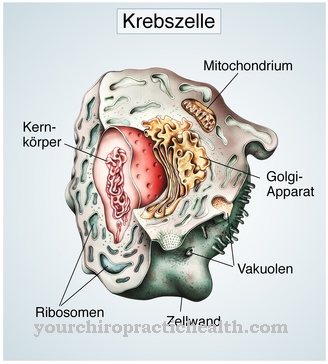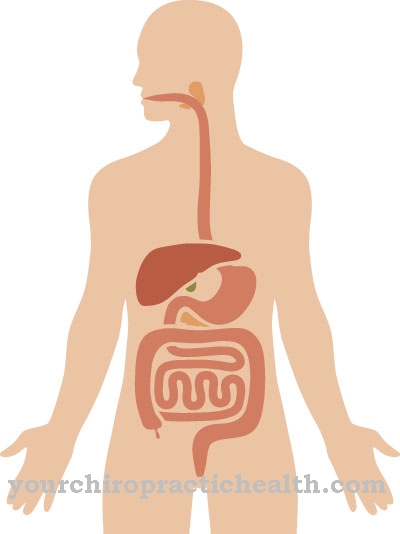At a Anthracosis (also Coal dust lung called) is a lung disease in which carbonaceous dust is deposited in the lungs. The mostly uncomplicated course of the disease occurs when a person inhales air polluted with soot and carbon particles over a long period of time. The disease was first researched at the beginning of the 20th century, when it was found particularly in workers in hard coal mines.
What is anthracosis?
Anthracosis (from the Greek anthrax, "coal") is a pathological change in the lungs. It is caused by inhaling carbonaceous dust. Long-term, excessive exposure of the person concerned overloads the self-cleaning mechanism of the lungs.
The soot and carbon particles that are inhaled with the air are consequently distributed in the lungs and are stored. It is deposited in the alveoli, the spaces between the cells of the bronchi and in the vicinity of blood and lymph vessels as well as in lymphatic vessels and nodes. The lungs become increasingly dark in color as a result of the deposits.
Anthracosis is a type of pneumoconiosis (Greek pneuma, "air" and konis, "dust"), which is also called pneumoconiosis. The lung tissue reacts to various inhaled and stored dusts. The individual types of pneumoconiosis are differentiated according to the type of dust that causes it.
The coal dust inhaled during anthracosis itself does not damage the lungs. A simple anthracosis is also usually not noticeable through symptoms. However, it can lead to other serious diseases of the lungs.
causes
Anthracosis is caused by inhaling air polluted with coal dust. People who have worked in a coal mine for several years are particularly affected. Other sources of the causing coal dust are the exhaust gases from internal combustion engines and cigarette smoke.
If a person inhales air that is heavily contaminated with soot and carbon particles for a long time, the self-cleaning mechanism of the lungs is overwhelmed: the bronchi and bronchioles (larger and smaller ramifications of the respiratory system) are lined with mucus-secreting cells and cilia. The mucus binds inhaled pollutants.
The cilia move the mucus with the foreign particles adhering to it incessantly out of the lungs towards the throat. There it is swallowed or coughed up. If the finest dust penetrates into the alveoli, macrophages (scavenger cells) as part of the immune system ensure that it is broken down.
Under normal conditions, the lungs clean themselves in this way. If this mechanism is overloaded, however, the dust particles can no longer be flushed out or broken down. They are distributed in the lungs up to the alveoli and are stored.
Symptoms, ailments & signs
If the inhaled coal dust is distributed in the lungs, it can close the airways as the disease progresses. The deposits show up in the form of small spots on chest x-rays. With simple anthracosis, there are usually no symptoms. If there is an additional disease of the respiratory tract, for example bronchitis, there is increased coughing and shortness of breath.
This is especially the case with smokers. Even with severe anthracosis, coughing and shortness of breath occur. If the anthracosis leads to emphysema, the person concerned suffers from shortness of breath. With advanced massive pulmonary fibrosis, which can also be triggered by anthracosis, there is a cough and severe shortness of breath up to severe shortness of breath.
Diagnosis & course
Anthracosis is diagnosed using imaging techniques. The doctor will take x-rays and perform computed tomography of the chest. Anthracosis shows up with characteristic spots in the lungs. The disease is usually uncomplicated.
In a small proportion of those affected, however, it develops into a more serious illness. Anthracosis can lead to the formation of emphysema. In this case, overinflation of the lungs leads to irreversible damage. Anthracosis also promotes other lung diseases, especially massive, progressive pulmonary fibrosis.
In the process, a lot of connective tissue forms in the lungs, which disrupts the uptake of oxygen. Pulmonary fibrosis can worsen even if the person no longer breathes carbonated air.
Complications
Anthracosis usually results in severe diseases of the lungs and airways. In most cases, the course of the disease and the complications that it entails will depend on how much carbon dust has accumulated in the patient's lungs. The anthracosis is often reversible so that there are no further consequential damage.
Anthracosis can cause acute shortness of breath and severe coughing in many patients. In some cases coughing up blood also occurs. If the cough gets worse, you may feel short of breath. In rare cases, anthracosis leads to death if the patient can no longer breathe.
If the anthracosis is not treated promptly by a doctor, irreversible damage to the lungs can occur. The symptom often only recedes slowly, even if the person concerned only inhales pure air. Problems with the lungs mean that persistent activities can no longer be carried out.
Above all, this has a negative effect on work and sport. In general, the everyday life of the patient is also made very difficult. Treatment usually does not take place. However, in the case of anthracosis, the patient must no longer breathe air containing carbon in order to alleviate the symptom.
When should you go to the doctor?

© pixelcaos - stock.adobe.com
Anthracosis should be clarified at the first signs of the disease. As soon as there is an increased cough and shortness of breath, a doctor must clarify the cause and, if necessary, treat it directly. Smokers and coal miners in particular should consult a doctor if they experience typical symptoms.
This is especially true if these are associated with health complaints or worsen the general condition. An emergency doctor should be called in the event of severe shortness of breath and coughing attacks. Sometimes there is also severe shortness of breath, in which first aid measures have to be taken until the rescue service arrives.
If an anthracosis is suspected, a doctor must be consulted in any case. Although most of the therapeutic measures can be carried out independently, a clear diagnosis is required for this. In addition, those affected should be vaccinated against pneumococci and flu to reduce the risk of infection. If left completely untreated, pneumonia can cause irreversible lung damage and other complications. In severe cases, anthracosis ends with death from asphyxiation.
Doctors & therapists in your area
Treatment & Therapy
Anthracosis cannot be cured. The course of the disease can, however, be slowed down or stopped by minimizing the exposure of the lungs to the air that contains carbon dust. If the patient suffers from shortness of breath, it may be necessary to take medication that keep the airways open and thin the mucus.
Outlook & forecast
The prognostic outlook for anthracosis depends on the degree of damage to the lungs and the airways. Nowadays, however, the chances of a cure are basically to be classified as good.
If the contact with coal and coal dust is considered to be low, this leads to a significant reduction in the disease and serious problems. In most cases, the deposits of coal dust do not lead to permanent damage to the lung tissue. Normally, this means that no functional impairment in lung activity is to be expected.
As soon as the person concerned can inhale sufficient oxygen, the symptoms are alleviated and the pollutants are removed. However, the airways are more susceptible to permanent damage. The vessel walls can be damaged by the soot particles.
With medical care, the symptoms usually subside almost completely within a few weeks. A complete cure of the anthracosis is then possible. The healing process is more difficult if there is also consumption of other harmful substances or toxins. The consumption of tobacco or cigarettes, for example, worsens the healing process.
It can lead to permanent tissue damage and cancer. Without treatment, there is a risk of life-threatening disease. If you completely abstain from nicotine, there will be a significant improvement within a few months and symptoms will be free after a few years.
prevention
Since an existing anthracosis cannot be cured, prevention is even more important. The exposure of the lungs to carbonaceous dust should be minimized by reducing the amount of coal dust emitted in the workplace. Ventilation systems and respiratory protection filters are also useful for cleaning the air we breathe, but do not offer complete protection.
People who regularly handle coal are advised to have annual chest x-rays. In this way, a possible disease can be discovered at an early stage. If the result is positive, the person concerned should be transferred to a workplace where the air is as little polluted as possible with coal dust.
This prevents the progression of the disease and advanced lung fibrosis. Smoking coal miners can reduce their risk of disease by quitting smoking. Coal miners can also get pneumococcal and flu vaccinations to protect against infections to which they may be more susceptible.
Aftercare
Anthracosis patients usually suffer from health problems for their entire life. After the disease has been completely treated, you have to go to regular follow-up care so that the progress of the existing symptoms can be checked. The doctor will also ask the patient whether and which unusual symptoms occur.
If coughing, shortness of breath or symptoms of bronchitis become noticeable, a drug may have to be prescribed. In the case of chronic complaints, alternative treatment methods are usually tested, for example special breathing exercises or the use of essential oils. If the anthracosis is associated with mental problems, the family doctor can call in a therapist.
This will support the patient in dealing with the disease in everyday life. Anthracosis follow-up also includes an examination of any permanent damage in order to assess possible compensation for the patient. The ENT doctor who has already taken on the treatment is responsible for the follow-up care. Follow-up checks should initially take place every one to two months.
If there are no major complications and all insurance-related questions have been clarified, the intervals between the appointments can be gradually extended. Anthracosis patients are permanently damaged and must have a comprehensive follow-up check carried out at least every six months after the end of the treatment.
You can do that yourself
Anthracosis cannot be cured, which is why prevention is particularly important. The lungs should not be burdened with carbonaceous dust or at least the burden should be kept as low as possible. In the workplace, coal dust emissions can be reduced by carefully selecting the machines and devices used and placing them correctly.
The use of special ventilation systems or respiratory protection filters may be indicated for risky activities or in a highly polluted environment. People who regularly come into contact with large amounts of coal dust, for example because they work in the coal and steel industry, should undergo a preventive check-up at least once a year.
If anthracosis has already been diagnosed, it is important to rule out further exposure of the lungs with coal dust as far as possible. This may require a change of job or profession. Those affected should also give up smoking so as not to put additional strain on the lungs.A vaccination against pneumococci and flu pathogens can also reduce the risk of infection.
In the case of severe shortness of breath and persistent coughing attacks, the emergency doctor must always be called immediately in the case of anthracosis, as there is an acute risk of suffocation for the patient.
The symptoms of the disease, especially permanent coughing or strong mucus formation, can be treated with mild household remedies in addition to the medication prescribed by a doctor. Steam baths with salt water or chamomile tea are helpful. Ribwort plantain has proven itself against strong coughs.






.jpg)

















.jpg)



